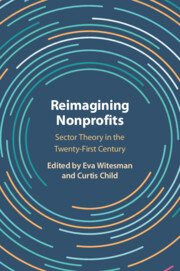Book contents
- Reimagining Nonprofits
- Reimagining Nonprofits
- Copyright page
- Contents
- Figures
- Tables
- Contributors
- Acknowledgments
- 1 An Invitation to Rethink the Nonprofit Sector
- Part I Overviews
- Part II Reflections and Refinements
- Part III New Directions
- 12 Nonprofits as Organizational Actors
- 13 Nonprofits as Enablers of Multilayered Representation
- 14 Nonprofits as Facilitators of National Self-development
- 15 Nonprofits as Part of an Engineered Social Economy
- 16 Nonprofits as Shaped by the Ruling Party
- 17 Nonprofits as Sources of Authoritarian Regime Stability
- 18 Nonprofits as Creators of Transformative Symbolic Reality
- 19 Nonprofits as Distributors of Toll Goods
- 20 Nonprofits as Agents of Moral Authority
- Part IV Conclusion
- Index
- References
16 - Nonprofits as Shaped by the Ruling Party
from Part III - New Directions
Published online by Cambridge University Press: 11 January 2024
- Reimagining Nonprofits
- Reimagining Nonprofits
- Copyright page
- Contents
- Figures
- Tables
- Contributors
- Acknowledgments
- 1 An Invitation to Rethink the Nonprofit Sector
- Part I Overviews
- Part II Reflections and Refinements
- Part III New Directions
- 12 Nonprofits as Organizational Actors
- 13 Nonprofits as Enablers of Multilayered Representation
- 14 Nonprofits as Facilitators of National Self-development
- 15 Nonprofits as Part of an Engineered Social Economy
- 16 Nonprofits as Shaped by the Ruling Party
- 17 Nonprofits as Sources of Authoritarian Regime Stability
- 18 Nonprofits as Creators of Transformative Symbolic Reality
- 19 Nonprofits as Distributors of Toll Goods
- 20 Nonprofits as Agents of Moral Authority
- Part IV Conclusion
- Index
- References
Summary
By following the Western mainstream theory on state–nonprofit relations, nonprofit research on developing countries usually overlooks the influence of political parties on nonprofits. However, political parties, particularly the ruling party, often decisively determine the development of the nonprofit sector in those societies. This article proposes a special model to analyze the state–nonprofit relations in the countries where a sole ruling party monopolizes the government. The model is applied in the one-party state of China to exemplify how the ruling Chinese Communist Party has fundamentally shaped the state–nonprofit relationship there in past decades. The article concludes with discussion about the model’s potentials and limitations.
- Type
- Chapter
- Information
- Reimagining NonprofitsSector Theory in the Twenty-First Century, pp. 313 - 332Publisher: Cambridge University PressPrint publication year: 2024

